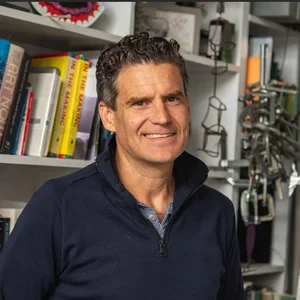A Conversation with New Sculpture Faculty John Umphlett
Coming to work at Bennington College is nothing new to new sculpture faculty John Umphlett; he has been a technical instructor in sculpture here for more than 20 years.

“In that position, you get pretty personal with students working in sculpture,” Umphlett said in an interview just before the fall term began. “When it comes to trying to understand the students’ inquiry, you start to imagine how a certain material or way of working or a direction may lend itself to their project.”
Beyond instructing on how to use all of the equipment safely, a major priority, Umphlett aimed to give students experience working with different materials as a way to build what he calls “a visual vocabulary,” a mental catalog of different materials—”plastics, metals, ephemera, leaves, dirt, whatever it might be,” he said—how they behave under different conditions and what those materials might be able to represent.
For example, he shares that when you heat, pull, and bend a piece of acrylic, a thermoforming plastic, it can look like saliva or mucus, or like a fluid in space.
People with a robust visual vocabulary are “able to mix more materials when trying to access an idea,” he said. “And the more you can do that, the more you can pull abstract thought into reality and allow that to have a relationship.”
Relationships are central to Umphlett. He sees relationships not just between the teacher and the student, the ideas and the material, or one material and another but also between the artist and their collaborators, the creator and the viewer, and the viewer and the work.
“When you experience sculpture, your mind is constantly referencing what you know, things, spaces that you've been to… It’s our nature; we want to understand it. We want to connect with it.”
He continued, “The attraction for being here, specifically at Bennington, is that there is something that happens when you realize that something has clicked, and it opens the way. Emotion and feeling can come and be present in the work. That’s pretty incredible. That’s what you look for.”
In taking the faculty position, Umphlett is focused on all of the interesting work of teaching students combined with expanding the department of sculpture at Bennington and its future.
The department is outfitted with the latest technology. There are two technologists with workshops equipped with the design and fabrication software and tools. In addition to using the laser cutter, 3D scanner, and 3D printers, students are interested in exploring soft materials like textiles and paper. So, Umphlett invited Lily Carone to teach “Papermaking with Plants” class.
“This paper making class is really exciting; they are actually going to go pick the plants. Find fibers that are appropriate and make an object,” Umphlett said. “This class allows us to tool up in a different way.”
It fits in well with Umphlett’s recent interest in prompting students to think critically about the materials they are using, where they come from, and how they are made. He urges students to acknowledge the unseen collaborators. In fact, he goes so far as to ask, “when you plug into the wall, where is that power coming from?”
“Ultimately, the people that help you, even not presently as you're physically making the work now, they're there,” Umphlett said. “It's a collaboration with the people designing the material that you're working with as well.”
The collaboration, though, is often much more visible and immediate, which is one of the more exciting aspects of sculpture for Umphlett.
This term he is teaching an introductory class called “Examining Space,” where students had the opportunity to pour iron during the Festival of Fire at Salem Artworks, an organization founded by Anthony Cafritz ’85 in 2005.
“Making sculpture, making art, can be an individual thing. Often it is. But going and producing work that is going to be poured in iron, you can't do it on your own,” Umphlett said. “It’s about the community of people together cooking the iron and helping pour your mold. And that’s what it’s really about.”
Students in introductory classes like “Examining Space,” especially, approach sculpture from a variety of angles, which leads to invigorating classroom discussions.
“Some of the most exciting critiques and conversations happen when I have a couple of students from dance, costume design, students from photography… they're bringing where they've been to a class. That's the interdisciplinary side.”
Umphlett is excited to deepen the artistic collaboration with students through advising, which is new to him as a faculty member.
“There are some students on my roster for the 4000-level class that I am super excited to just watch them,” Umphlett said. “I have been witnessing them in some other classes, and now they are in a class where there’s serious focused time for them to really hone in on their thoughts in a studio space. A plethora of their inspirational things will clad the walls, and you can start to see a little deeper into this individual.”
Once in a while, a student who has helped with his work, an intern or a Field Work Term student, becomes a colleague.
“I had a student who was graduating who was actually a part of a performance I did. To have graduated and still have a connection within the work is really special on a different level,” Umphlett said. “It’s just another layer of the relationships, how these things come to fruition and how they continue.